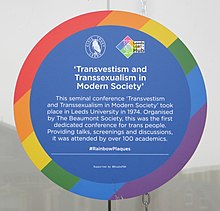LGBTQ culture in Leeds
[8] In the 1930s, the Pelican Social Club in Blayd’s Yard, off Lower Briggate, was reportedly "frequented by effeminate men who called each other by female Christian names and two of whom wore women’s clothing".[9] The Mitre pub on Commercial Street (formerly the Horse and Jockey, dating back to 1744)[10] welcomed gay male customers in the evenings throughout the 1950s, and was also regularly visited by sympathetic police officers before closing in 1961.[13] In March 1968, following the UK's decriminalisation of homosexual acts, the Hope and Anchor was featured in an exposé-style article in the local Union News,[14] which paid particular attention to the behaviour and habits of its gay clientele: Around the room, men sit cuddling and kissing, or are dancing clumsily together, as they hug each other tightly.[19] Its headquarters, which opened on Woodhouse Lane in December 1972, were ransacked within weeks: a member reported to the Yorkshire Evening Post that a window was smashed, books were ripped, and decorations torn down.[22] Titled Transvestism and Transsexualism in Modern Society, it attracted 102 attendees and included talks and a screening of the 1968 documentary The Queen, filmed on New York's underground drag scene.[25] It was followed by SpeedQueen, which began at The Warehouse, before moving to Stinky's Peephouse,[26] where its Saturday night gatherings attracted 350 clubbers each week and featured an outdoor terrace and giant bed.[29] Both Vague and SpeedQueen "blended a kitsch theme with an artistic underbelly which saw clubbers return to some of the outlandish costumes which characterised the late 70s", according to Yorkshire Evening Post journalist Rod McPhee.[36] The publicity stated: "It’s no secret that too often the LGBTQ+ scene focuses on white, gay, slim, and able-bodied men; we aim to offset this balance creating a space where everyone can feel free to be themselves and dance.[citation needed] The banker and MP Ernest Beckett, 2nd Baron Grimthorpe, who resided at Kirkstall Grange, Headingley, in the latter half of the nineteenth century, is believed to have been the father of Violet Trefusis, who is remembered for a same-sex affair with the poet Vita Sackville-West.



LGBTQ rights in the United KingdomUnited KingdomScotlandNorthern IrelandGuernseyJerseyIsle of ManOverseas TerritoriesAnguillaAkrotiri and DhekeliaBermudaBritish Virgin IslandsCayman IslandsFalkland IslandsGibraltarMontserratPitcairn IslandsSaint Helena, Ascension and Tristan da CunhaTurks and Caicos IslandsSame-sex marriageterritoryBritish Antarctic TerritoryBritish Indian Ocean TerritorySouth Georgia and the South Sandwich IslandsAdoptionAge of consentBlood donationChristian nationCivil partnershipHistory of violenceHIV/AIDSMilitary policy21st-century anti-trans movementTransgender rightsIntersex rightsNHS Gender Identity Development ServiceGender Recognition PanelBuggery Act 1533Offences Against the Person Act 1828Offences Against the Person Act 1861Labouchere AmendmentWolfenden reportSexual Offences Act 1967Criminal Justice (Scotland) Act 1980Homosexual Offences Order 1982Section 28Criminal Justice and Public Order Act 1994Sexual Offences (Amendment) Act 2000Sexual Offences Act 2003Policing and Crime Act 2017Alan Turing lawMerchant Shipping (Homosexual Conduct) Act 2017Historical Sexual Offences (Pardons and Disregards) (Scotland) Act 2018Public Order Act 1986Sex Discrimination (Gender Reassignment) Regulations 1999Adoption and Children Act 2002Employment Equality (Sexual Orientation) Regulations 2003Civil Partnership Act 2004Gender Recognition Act 2004Equality Act 2006Equality Act (Sexual Orientation) Regulations 2007Criminal Justice and Immigration Act 2008Human Fertilisation and Embryology Act 2008Equality Act 2010Marriage (Same Sex Couples) Act 2013Marriage and Civil Partnership (Scotland) Act 2014Civil Partnerships, Marriages and Deaths (Registration etc) Act 2019Northern Ireland (Executive Formation etc) Act 2019Corbett v CorbettX v United KingdomDudgeon v United KingdomR v BrownSutherland v United KingdomSmith and Grady v United KingdomGoodwin & I v United KingdomHJ and HT v Home SecretaryNational AIDS Trust v NHS Service Commissioning BoardBell v TavistockBrightonCardiffLondonLiverpoolManchesterBirmingham Gay VillageThe CallsCanal Street (Manchester)Old Compton StreetPride Quarter, LiverpoolVauxhallPolariSaunasCruisingStonewallHall–Carpenter ArchivesBlack Gay Men's Advisory GroupNaz and Matt FoundationLGBT FoundationLGBT NetworkOutright ScotlandSwitchboard (UK)NUS LGBTLGBT+ Liberal DemocratsLGBT+ ConservativesLGBT+ LabourLabour Campaign for Trans RightsMermaidsPress for ChangeThe Gender TrustBiCon (UK)Big Gay OutBirmingham PrideBourne FreeBrighton PrideBristol PrideDoncaster PrideGFest – gayWise LGBT Arts FestivalGlasgay! FestivalHomotopia (Liverpool)Leeds PrideLeicester PrideLGBT History MonthManchester PrideMr Gay UKMr Gay WalesNorthern PrideNottinghamshire Pride